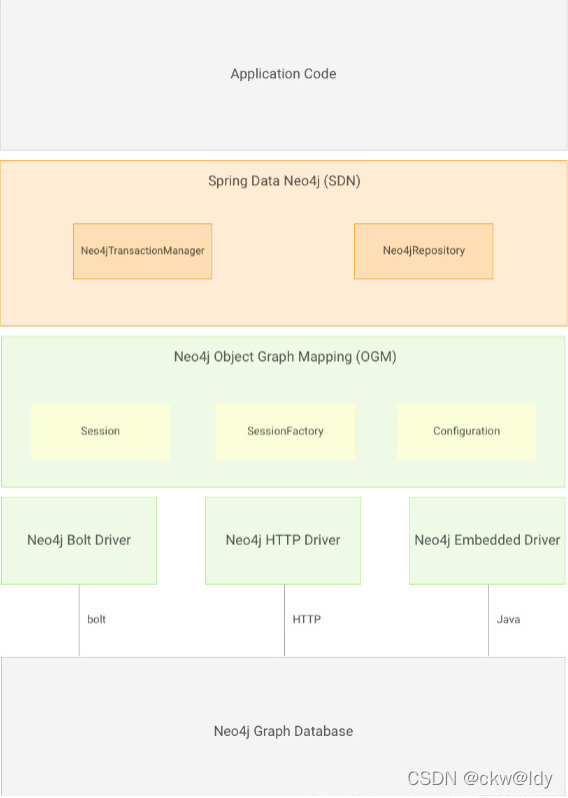Neo4j的两种方式访问(嵌入式访问、服务器模式访问)-- java客户端连接和SpringBoot整合Neo4j
一、Neo4j数据库访问
1、Neo4j数据库访问
- 嵌入式数据库
- 服务器模式(通过REST的访问)
它是由应用程序的性质(neo4j是独立服务器 还是和程序在一起),性能,监控和数据安全性来决定架构选择。
2、An embedded database(嵌入式数据库)
嵌入式Neo4j数据库是性能的最佳选择。 通过指定数据存储的路径以编程方式访问嵌入式数据库。我们选择嵌入式数据库出于以下原因:
使用Java作为我们项目的编程语言时
- 应用程序是独立的
- 程序追求很高的性能
3、Neo4j Server(服务器模式)
Neo4j Server是相互操作性,安全性和监控的最佳选择。 实际上,REST接口允许所有现代平台和编程语言与它进行互操作。 此外,作为独立应用程序,它比嵌入式配置更安全(客户端中的潜在故障不会影响服务器),并且更易于监控。 如果我们选择使用这种模式,我们的应用程序将充当Neo4j服务器的客户端。要连接到Neo4j服务器,可以使用任何编程语言的REST 访问数据库。
二、Java客户端操作Neo4j
1、嵌入式模式
<dependency>
<groupId>org.neo4j</groupId>
<artifactId>neo4j</artifactId>
<version>3.5.5</version>
</dependency>
public class EmbeddedNeo4jAdd {
private static final File databaseDirectory = new File( "target/graph.db" );
public static void main(String[] args) {
GraphDatabaseService graphDb = new GraphDatabaseFactory().newEmbeddedDatabase(databaseDirectory);
System.out.println("Database Load!");
Transaction tx = graphDb.beginTx();
Node n1 = graphDb.createNode();
n1.setProperty("name", "张三");
n1.setProperty("character", "A");
n1.setProperty("gender",1);
n1.setProperty("money", 1101);
n1.addLabel(new Label() {
@Override
public String name() {
return "Person";
}
});
String cql = "CREATE (p:Person{name:'李四',character:'B',gender:1,money:21000})";
graphDb.execute(cql);
tx.success();
tx.close();
System.out.println("Database Shutdown!");
graphDb.shutdown();
}
}
public class EmbeddedNeo4jQueryAll {
private static final File databaseDirectory = new File( "target/graph.db" );
public static void main(String[] args) {
GraphDatabaseService graphDb = new GraphDatabaseFactory().newEmbeddedDatabase(databaseDirectory);
System.out.println("Database Load!");
String cql = "MATCH (a:Person) where a.money < $money return a";
Map<String, Object> paramerters = new HashMap<String, Object>();
paramerters.put("money", 25000);
Transaction tx = graphDb.beginTx();
Result result = graphDb.execute(cql,paramerters);
while (result.hasNext()) {
Map<String, Object> row = result.next();
for (String key : result.columns()) {
Node nd = (Node) row.get(key);
System.out.printf("%s = %s:%s%n", key,
nd.getProperty("name"),nd.getProperty("money"));
}
}
tx.success();
tx.close();
System.out.println("Database Shutdown!");
graphDb.shutdown();
}
}
2、服务器模式
<dependency>
<groupId>org.neo4j</groupId>
<artifactId>neo4j-ogm-bolt-driver</artifactId>
<version>3.2.10</version>
</dependency>
public class Neo4jServerMain {
public static void main(String[] args) {
Driver driver = GraphDatabase.driver( "bolt://127.0.0.1:7687",
AuthTokens.basic( "neo4j", "123456" ) );
Session session = driver.session();
String cql = "MATCH (a:Person) WHERE a.money > $money " +
"RETURN a.name AS name, a.money AS money order by a.money ";
Result result = session.run( cql,parameters( "money", 1000 ) );
while ( result.hasNext() )
{
Record record = result.next();
System.out.println( record.get( "name" ).asString() + " " +
record.get( "money" ).asDouble() );
}
session.close();
driver.close();
}
}
public class Neo4jServerMain2 {
public static void main(String[] args) {
Driver driver = GraphDatabase.driver( "bolt://127.0.0.1:7687",AuthTokens.basic( "neo4j", "123456" ) );
Session session = driver.session();
String cql = "MATCH p=shortestPath((person:Person {name:$startName})-[*]-(person2:Person {name:$endName} )) RETURN p";
Result result = session.run( cql,parameters("startName","王启年","endName","九品射手燕小乙") );
while ( result.hasNext() )
{
Record record = result.next();
System.out.println(record);
}
session.close();
driver.close();
}
}
三、SpringBoot 整合Neo4j

1、导入jar
<dependency>
<groupId>org.springframework.boot</groupId>
<artifactId>spring-boot-starter-data-neo4j</artifactId>
</dependency>
<dependency>
<groupId>org.neo4j</groupId>
<artifactId>neo4j-ogm-bolt-driver</artifactId>
</dependency>
2、建立实体类
@NodeEntity
public class Person {
@Id
@GeneratedValue
private Long id;
@Property("cid")
private int pid;
private String name;
private String character;
private double money;
private int age;
private String description;
@Relationship(type = "Friends",direction = Relationship.OUTGOING)
private Set<Person> friendsPerson;
public Set<Person> getFriendsPerson() {
return friendsPerson;
}
public void setFriendsPerson(Set<Person> friendsPerson) {
this.friendsPerson = friendsPerson;
}
public Person(Long id, int pid, String name, String character, double money, int age, String description) {
this.id = id;
this.pid = pid;
this.name = name;
this.character = character;
this.money = money;
this.age = age;
this.description = description;
}
public Person() {
}
public Long getId() {
return id;
}
@Override
public String toString() {
return "Person{" +
"id=" + id +
", pid=" + pid +
", name='" + name + '\'' +
", character='" + character + '\'' +
", money=" + money +
", age=" + age +
", description='" + description + '\'' +
", friendsPerson=" + friendsPerson +
'}';
}
public void setId(Long id) {
this.id = id;
}
public int getPid() {
return pid;
}
public void setPid(int pid) {
this.pid = pid;
}
public String getName() {
return name;
}
public void setName(String name) {
this.name = name;
}
public String getCharacter() {
return character;
}
public void setCharacter(String character) {
this.character = character;
}
public double getMoney() {
return money;
}
public void setMoney(double money) {
this.money = money;
}
public int getAge() {
return age;
}
public void setAge(int age) {
this.age = age;
}
public String getDescription() {
return description;
}
public void setDescription(String description) {
this.description = description;
}
}
3、数据持久层
@Repository
public interface PersonRepository extends Neo4jRepository<Person,Long> {
/** 查看money 大于指定值的Person 列表 */
//@Query("match(p:Person) where p.money>{0} return p")
@Query("match(p:Person) where p.money>{money} return p")
List<Person> personList(@Param("money") double money);
/** 指定开始的名字 和 结束的名字 查询最短路径 限定深度为4以层包含4*/
@Query("match p=shortestPath((person:Person{name:{startName}})-[*1..4]-(person2:Person {name:{endName}})) return p")
List<Person> shortestPath(@Param("startName") String startName,@Param("endName") String endName);
@Query("match p =(person:Person {name:{name}})-[*1..2]-(:Person) return p")
List<Person> personListDept(@Param("name") String name);
}
4、配置文件 application.yml
spring:
data:
neo4j:
username: neo4j
password: 123456
uri: bolt://localhost:7687
5、编写服务类
@Service("personService")
public class Neo4jPersonService {
@Autowired
private PersonRepository personRepository;
public List<Person> getAll(){
List<Person> datas = new ArrayList<>();
personRepository.findAll().forEach(person -> datas.add(person));
return datas;
}
public Person save(Person person){
return personRepository.save(person);
}
public List<Person> personList(double money){
return personRepository.personList(money);
}
public List<Person> shortestPath(String startName,String endName){
return personRepository.shortestPath(startName,endName);
}
public List<Person> personListDept(String name){
return personRepository.personListDept(name);
}
}
6、编写测试类
@SpringBootApplication
public class Neo4jBootAppMain {
public static void main(String[] args) {
ApplicationContext applicationContext = SpringApplication.run(Neo4jBootAppMain.class,args);
Neo4jPersonService personService = applicationContext.getBean("personService",Neo4jPersonService.class);
Person person = new Person();
person.setName("testboot");
person.setMoney(12345.45);
person.setCharacter("A");
person.setAge(11);
Person p1 = personService.save(person);
System.out.println(p1);
System.out.println(personService.getAll());
List<Person> personList = personService.personList(1000);
System.out.println(personList);
List<Person> personList2 = personService.shortestPath("王启年","九品射手燕小乙");
System.out.println(personList2);
List<Person> personList3 = personService.personListDept("范闲");
for (Person pe:personList3){
System.out.println(pe);
}
}
}